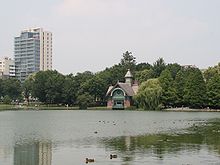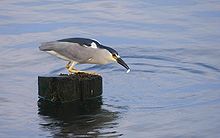- Harlem Meer, Central Park
-
Coordinates: 40°47′47.8″N 73°57′6″W / 40.796611°N 73.95167°W
Harlem Meer ("Meer" is Dutch for "Lake") occupies the northeast corner of New York City's Central Park, in a section of park that was added to the original site, which had originally ended at 106th Street. It lies north of the Conservatory Garden, with a meandering and diverse shoreline that wraps around the bluff that contains the Blockhouse, the remains of gun emplacements erected for the War of 1812, which never saw action. Today Harlem Meer has been reduced to 11 acres (45,000 m2) and 1.2 kilometers (3/4 mile) circumference by the construction of Lasker Rink and Pool in 1966, for summer swimming and winter ice-skating, over its westernmost end.
The Meer, as Frederick Law Olmsted and Calvert Vaux called it, was excavated in the lowest-lying section of the park, a semi-brackish, partly tidal wetland, which drained slowly into the East River; as Harlem Commons[1] It separated the former suburb of Harlem to the north from the lower part of Manhattan Island. To avoid the swamp, the Boston Post Road had detoured westwards into the future park site, rising to cross McGown's Pass.[2] The Meer and its wooded landscape were carried out by Andrew Haswell Green, to Olmstead and Vaux's specifications, from 1861, while Olmsted had been relegated to an advisory capacity.
Harlem Meer once again has natural-seeming banks, restored in 1988-93 after a 1940s concrete curbing was removed, and the Meer was cleaned of 34,000 cubic yards (26,000 m3) of sediment and debris[3] and redredged. On its north shore, the Charles A. Dana Discovery Center was constructed, to provide visitor orientation for the north end of Central Park, in a style intended to harmonize with Calvert Vaux's original Victorian park structures. The waterside plaza next to it is the site for the late-afternoon Harlem Meer Performance Festival, from mid-June to the first week of September. Catch-and-release fishing is a favorite summertime occupation along the Meer's banks.
An island in the Meer provides a retreat for waterfowl, particularly Black-crowned Night Heron. The meer also has a resident population of muskrats.
Contents
References in culture
Literature
The angler, artist, and author Ron P. Swegman has made Harlem Meer the focal point of the essay collection Small Fry: The Lure of the Little[4]. The book includes a section titled "Bright Fish, Big Cities", a pun on the New York novel "Bright Lights, Big City" by Jay McInerney; it details the Meer's history and describes the experience of fly fishing there in the twenty-first century.
Notes
- ^ Harlem Commons was disputed between the City of New York and the heirs of the Harlem freeholders for most of the 18th century. It was divided into house lots and sold in 1825. (James Riker, Harlem (City of New York): its origin and early annals 1881, p. 472f.
- ^ "Early New York History: Old Days In Yorkville And Harlem" 1893
- ^ Central Park Conservancy, 1989-92.
- ^ The Whitefish Press, 2009
External links
References
(See Central Park#References)
Features of Central Park Features The Arsenal • Belvedere Castle • Bethesda Terrace • The Blockhouse • Bridges • Central Park Mall • Cleopatra's Needle • Conservatory Garden • Conservatory Water • Delacorte Theater • Diana Ross Playground • Dipway Arch • Gapstow Bridge • Great Lawn • Harlem Meer • Jacqueline Kennedy Onassis Reservoir • King Jagiello Monument • The Lake • Lasker Rink • Marionette Theatre • Medical Unit • The Pond and Hallett Nature Sanctuary • The Ramble • Rat Rock • Sculptures • Seneca Village • Strawberry Fields • SummerStage • Tavern on the Green • Wollman Rink • Zoo • Zoo York Wall
Events Streets Borders: Fifth Avenue • Central Park North • Central Park South • Central Park West
Transverses: 79th Street • 85th Street/86th Street • 96th StreetPeople and animals Categories:
Wikimedia Foundation. 2010.



